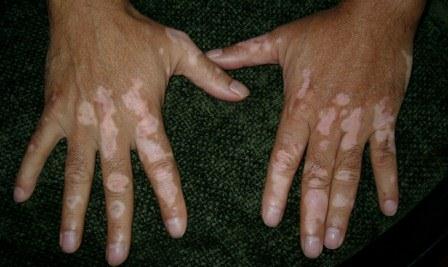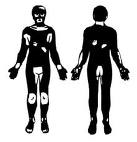|

Vitiligo

Vitiligo
There are many different causes which result in the absence of pigment producing cells (melanocytes) in the affected skin. E.g. Vitiligo, Piebaldism, Waardenburg’s syndrome, Chemical leucoderma (caused by chemical peeling or exposure to melanocytotoxic compounds) Skin burns (caused by light pulse/laser hair removal ), Fungal and Bacterial infections, Naevus anemicus, Amelanotic naeus, Blaschko’s lines , Post-inflammatory disorders etc.
Vitiligo: Occurs in 1-2% of the general population and is a heterogenic group. Vitiligo is a very complex disease and the aetiology (background cause) is both polygenetic and multifactorial. For this reason every patient has to be treated as an individual unique case to achieve the best results with a suitable treatment regimen. Very simplified vitiligo can be sub grouped into 3 different types.
- The generalized type of vitiligo is the most common and appears often as symmetrical and bilateral spots/blotches. It usually progresses over the years and has elements of autoimmunity. Generalised vitiligo, also called Vitiligo Vulgaris, is the most heterogenic and complex group and consists of several sub variants.
- Segmental vitiligo is another type of vitiligo, which is localized, unilateral and remains unchanged over the years. The distribution follows one or two neighbouring sensory nerve segments and an elevated level of local neuropeptides can be detected during the active phase.
- Halo naevi is another type of vitiligo appearing as unpigmented circles/fields around brown moles (naevi). After some time the naevi can fade away, but the white areas usually remain. In active halo naevi there is elevated levels of leucocyte infiltrate in the area and elements of autoimmune activity towards the own melanocytes (pigment cells).
Different subtypes of vitiligo can appear in the same individual.
Piebaldism: This is not vitiligo and the absence of pigmentation in some areas is due to a migration fault of the melanocytes from the neural crest to the skin during the embryogenesis. The irregular areas are totally stable/refracted to pharmaligical or UV therapies and often located on the forehead and the central parts of the body and or extremities.
Chemicals: Especially aromatic structures such as phenols, hydroquinones can cause pigment loss. The chemical destruction of the melanocytes (pigment cells) can sometimes also induce generalized vitiligo, which destroys melanocytes also remote from the site of exposure.
|
After more than 25 years in the field we know Vitiligo and how to fight it! |

|
|




News
Headlines »
Together with Colorado University in USA (Professor Richard Spritz) we are conducting a new vitiligo study there we look on what specific genes are involved in the development of vitiligo. At the Vitiligo Society meeting in Stockholm , May 24 2014, we will collect samples from all patients who would like to participate in the study. The sample is easy to collect (just a saliva sample), and there is no costs involved in participation. This type of study aim to understand the underlying factors better and thereby in the near future be able to direct a more precise and effective treatment.
For more information about the Vitiligo Society meeting, see Link below.
Headlines »
International Vitiligo Center has in November 2016 initiated a new collaboration with a treatment center in Geneva, Switzerland. For more info See www.swissvitiligocenter.com.
Headlines »
New Vitiligo device:
In September 2011 The International Vitiligo Center has finalized an agreement to be a European agent for the new targeted
(focused) UBV device Levia® for the
effective treatment of vitiligo.
Headlines »
Headlines »
|